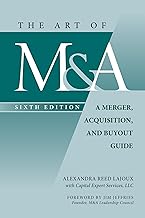
The Art of M&A® / Postmerger Integration
An excerpt from The Art of M&A, Sixth Edition: A Merger, Acquisition, and Buyout Guide by Alexandra Reed Lajoux
COMBINING COMPANY NAMES AND/OR LOGOS
If two major companies combine, what considerations arise when deciding on the name and/or logo of the new company?
A company’s name and logo (along with the names and logos of any brands it may own) can constitute a significant percentage of its value. This is why intellectual property law protects trademarks.11 When a company’s name is its primary brand, the choice of a new moniker is particularly important. Numerous studies of postmerger financial performance show that attention to brand pays off. 12
When one company buys another, it has 16 basic choices regarding its new name/s or logo/s.
(The four basic ones described below.)
What are the pros and cons of these different approaches?
■ Keeping the acquirer’s name is the simplest approach, and it is often a wise course for high-profile companies that buy low-profile companies—or for companies that buy firms that are very similar to them, when nothing can be gained from incorporating the target company’s brand name. The chief drawback will be a sense of loss by the acquired company’s employees. There is also a dollars-and-cents issue for the company as a whole and its owners: if the selling company has name recognition, as most companies worth buying do, the value of this trade name might be diminished, along with any trademark value it may have.
■ Adopting the seller’s name is good for acquirers that need to gain cachet from the seller’s company. The chief advantages and disadvantages here are the same as in the first example, but with acquirer and seller roles reversed.
■ Putting the two names together, with or without acronyms, has the advantage of bolstering the pride of both parties. On the other hand, it poses the challenge of a dual identity to be understood both within and outside the company.
■ Creating an entirely new name avoids this challenge while creating another one: what to call the new company. Of all the communication challenges facing newly combined companies, this one is paramount. (In fact, the comprehensive communications grid that appears in Exhibit 9-1 was originally developed as a grid to announce company name changes.) In this option, the potential sense of loss is doubled. Employees from both the acquired and the acquiring company may feel a sense of abandonment. And customers may not like—or even recognize—the name of the merged company.
How do buyers and sellers decide whether to use old or new names? And how do they create new names?
Sometimes the best course for naming a newly combined entity will be obvious. If a large, successful company buys a small, struggling firm in its industry, the acquirer’s name should probably prevail, unchanged, especially if that acquirer has already changed its name within the past few years. Usually, however, the choice is not so easy.
Merging companies would be wise to appoint a small group of managers to look into this important question. There are basically 12 steps. (See Exhibit 9-3 and the discussion that follows.)
|
Exhibit 9-3 Steps for Naming a Newly Combined Company |
|
1. Compare present names with future of company. 2. Determine needs and expectations of stakeholders. 3. Develop criteria for a new name. 4. Develop a long list of names. 5. Review/screen names to make short list. 6. Conduct preliminary legal search. 7. Evaluate attributes, both graphic and linguistic, considering a global market.* 8. Select final candidates. 9. Conduct final legal search. 10. Recommend new name to board and stockholders. 11. Seek approval from board and stockholders. 12. Develop communications plan. * The old Chevy Nova brand was reportedly mocked in Spanish-speaking markets because “no va” implies that the car will not run. |
Step 1: Compare Present Names with Future of Combined Company
Managers can ask themselves honestly if the existing company names—separately or in combination—adequately convey the range of the products and services the new company will offer. Is the company expanding? Is it planning to sell off noncore businesses? What qualities does the company want to project?
Step 2: Determine the Needs and Expectations of Stakeholders
Managers or their agents (designated employees or consultants) can then interview representatives of each stakeholder group to find out what they think of the businesses that are combining. This includes customers, suppliers, stockholders, bondholders, lenders, employees, and people in the communities where the companies are headquartered.
Step 3: Develop Criteria for a New Name
In listing criteria, managers should ensure suitability with as many facets of the company as possible. Here is a quick checklist of 10 important attributes of a name:
■ Descriptive of the combined companies’ core business?
■ Suitable to the products, services, and (if regional) location of subsidiaries?
■ Broad enough to suit the present while leaving room for growth in the future?
■ Acceptable to the company’s stakeholders?
■ Distinctive rather than clichéd?
■ Memorable rather than arcane?
■ Pronounceable or a tongue-twister?
■ Real-sounding or outlandish?
■ Self-explanatory or a stretch?
■ Legally available?
Step 4: Develop a Long List of Names
Now is the time for maximum creativity; the decision-making group may wish to include additional employees and/or outside consultants for brainstorming at this point. In generating a list of possible names, managers can use key prefixes, suffixes, and word fragments to imply general image attributes, such as “Uni” for centralization, “Max” for scale, or “Excel” for quality. Some industries favor certain themes. For example, one study found that two out of three banks have one of the following five words in their names: state, first, national, trust, and savings.13 To add to the list, a computer can be programmed to generate random names. In the end, the list should include up to several hundred names for a large, complex company.
Step 5: Review Names, Making a Short List
Next, managers should winnow the list down to 25 to 35 acceptable candidates. In this process, they should bear in mind that no single name can fulfill all criteria. It is up to senior management to set priorities. Managers might assign points for each desired attribute—with extra points for the attributes that matter most. They might also decide that failure on certain key points will mean automatic rejection, despite the overall score.
Step 6: Conduct Preliminary Legal Search
Although the process of obtaining legal clearances can be long and frustrating, a full corporate designation must be legally cleared, registered, and protected in accordance with statutes governing its use. Depending on the size of the business and its market, a preliminary search must be conducted at the national, state, and/or local level to identify the legal availability of names on the list. (Sometimes the search must be conducted internationally, nation by nation.) It is fairly typical at this point to find that most of the names are already taken. In addition, it is important to secure website URLs. Even if there is no legal entity named “XYZ Inc.,” some domain collector might have secured “XYZInc.com.”
Step 7: Evaluate Graphic and Phonetic Attributes
In the process of narrowing down the choice, managers should begin to get a feel for what it will be like living with each of the names. At this point, they should begin to pay especially close attention to the way the name looks and sounds. The name selected must be adaptable to a variety of media, both real and virtual, visual and auditory—sometimes in many languages.
Step 8: Select Final Candidates
By now, a company may have about a dozen name finalists. At this point, it is time to make a final choice. One way to do this is to take two names at a time and select only one each time—a process called pairwise comparison—continuing to evaluate the attributes listed so far. At the end, only one name will survive. For a guide to pairwise comparison (a technique that can be used for many aspects of integration—not just name choices), see Appendix 9E.
Step 9: Obtain Final Legal Clearance for Use of the Name
Having selected a name, managers should ask their legal counsel to begin the paperwork for obtaining the legal right to use the name and any images and URLs associated with it, pending board and stockholder approval. As mentioned, trademarks have value, so this is an important step.
Step 10: Seek Approval from the Board and/or Stockholders
In most situations, it will be necessary to seek approval for the name change from a board of directors and from owners. In seeking approval, managers should disclose the criteria and process they used to select the new name, and the benefits that a new name may bring.
Step 11: Create a Graphic System for the New Name
Once the name is selected and approved, it will be time to design a graphic system for it, which will include such visual elements as logos, symbols, and type fonts, as well as color palettes, for the name’s expression in all foreseeable applications.
Step 12: Develop a Communications Plan
Managers should decide when to announce the name change, leaving adequate time for updating both physical materials (signs, swag, etc.) and virtual materials (website, social media). After the announcement, the company should use only the new supplies. The announcement (which is sometimes coupled with the announcement of the merger itself) should be made not only through the usual channels of communication, but also in special mailings or meetings tailored to specific stakeholder concerns. The company should be sure to include information about the new name in the part of its website devoted to the merger. One of the FAQs (frequently asked questions) often posted about mergers is “What is the name of the new company?”
In the end, the burden of proof will be on the new owner, who must demonstrate that the values underneath the company name and logo will survive and indeed thrive under a new banner.
11 See especially https://www.uspto.gov/trademarks/basics/what-trademark
12 “Brand Equity Valuation after Merger and Acquisition: A Review of Evidence,” Journal of Service Science and Management, Vol.16 No.2, April 2023. Brand Equity Valuation after Merger and Acquisition: A Review of Evidence (scirp.org)
13 Carol Gilhawley, “Time to Bank on a Name Change,” ABA Marketing, July 11, 2017. Also see Brandon Kochkodin, What’s in a Hedge Fund Name,” Bloomberg, May 16, 2018, https://www.bloomberg.com/news/articles/2018-05-16/what-s-in-a-hedge-fund-name-apparently-booze-boats-and-boston.
_________________________________________________________________________

Learn more about mergers, acquisitions and divestitures at M&A Leadership Council's virtual or in-person training courses. Network with other M&A professionals while our expert consultant trainers will get you ready for your next transaction (or help an ongoing one) through practical insights, group discussions, case studies, and breakout exercises.
Lajoux, Alexandra Reed with Capital Expert Services. The Art of M&A, 6th Edition: A Merger, Acquisition, and Buyout Guide. United States of America: McGraw Hill, 2024.